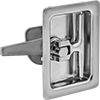Filter by
Latching Distance
Mount Type
Opens With
Through-Hole Diameter
Cam Latch Type
Latch Turn Direction
Finish
DFARS Specialty Metals
Nose Diameter
Latching Distance Adjustability
Nose Material
Environment
Handle Material
Straight Cam Length
Body Material
Building and Machinery Hardware
Fastening and Joining












































